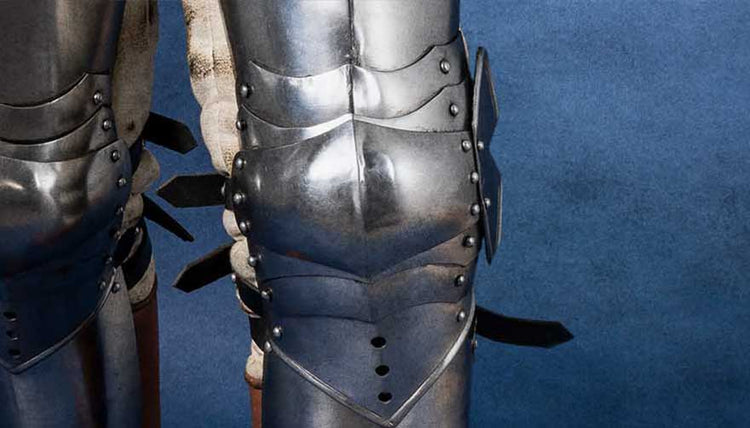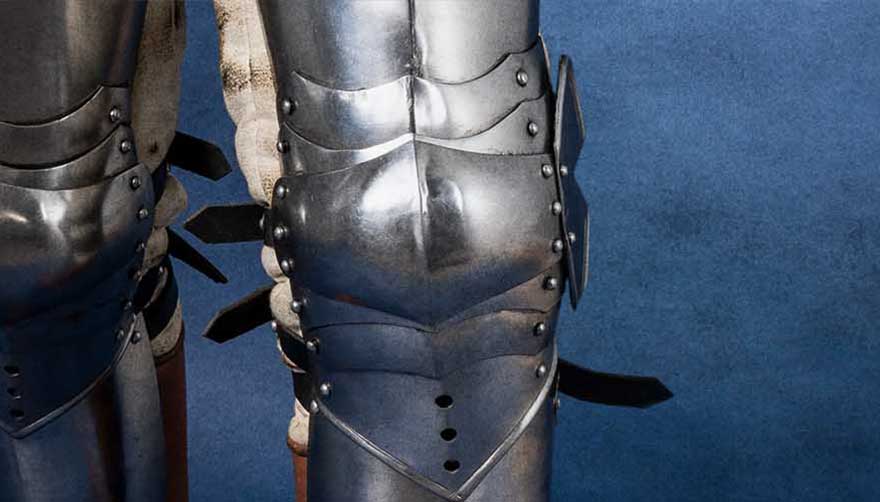Leg Gear
A medieval soldier literally had to be good on his feet. Figuratively speaking, very few battles took place right outside the front door. Large-scale battles were typically far from home, deep in enemy territory. A particularly outstanding example is probably the Crusades. Three years and about 3,000 kilometers lay between the call of Pope Urban II and the invasion of the crusaders in the Promised Land, which were also carried out by sea, but in large parts "on foot." Only a comparatively small number of the high-born made the journey on horseback. The vast majority made the arduous journeys on foot.
Not surprisingly, legs and feet were of elementary importance to a warrior. Against the consequences of the long marches little could be done. In addition to disease and hunger, it was certainly pure debilitation that often decimated armies more significantly than the actual battles. But even those who reached the battlefield and faced the enemy eye to eye had to worry about their legs. A hit by the enemy or falling from one’s horse, which often led to a serious leg injury, did not have to immediately cost the warrior their life, but those who could no longer hold on to the horse or run with stamina, were often doomed to die. It did not even require the most serious injuries or broken bones, even a simple cut could, under the hygienic conditions of the Middle Ages, easily escalate to life-threatening proportions.
Knights were no less at risk than simple foot soldiers. On the contrary, the legs of a mounted fighter were even more likely to be within the range of a foot soldier's weapons. Accordingly, it was important to protect one’s legs as well as possible.
Leg Protection From Roman Times to the Middle Ages
From the time before the Roman Empire, the existence of leg splints are archaeologically almost impossible to prove. Only as a consequence of Roman influence did these show up, and at the time were reserved for army leaders and higher social classes, thus making them immensely valuable.
Simple foot soldiers tried to protect themselves as well as possible by wrapping their lower legs with bands of linen or leather. Knights, who could also afford it financially, initially protected only the right leg, which was not guarded by a shield in battle due to a lunge.
The first greaves consisted, comparable to early bracers, of individual flat irons or metal plates attached to a leather stocking.
Throughout the Early and High Middle Ages greaves increasingly developed that were made entirely of metal and covered the whole shin, from the instep to below the knee. As simple molded plates, these were held to the calf with straps.
Three-piece, enclosed greaves covered both shin and calf.
An additional riveted attachment could protect the knee and was placed so that, if possible, it did not noticeably restrict the knee joint's range of motion.
With the spread of plate armour in the late Middle Ages, leg gear is also perfected. Plate legs cover the thighs to the bottom of the chain mail. Their shape, adapted to the body, covers the front of the thighs. The attachment was also made by straps on the back of the leg.
Plate legs additionally covered the knees. For this purpose, they had metal hemispheres attached by movable joints to the thigh plates and a short piece of plate over the shins.
As knee tiles, knee humps, or knee caps, knee protection could also be worn separately.
Beaked shoes made of metal completed an entire set of plate armour.
We Keep You on Your Toes
Of course, greaves and plate legs are no longer the luxury they were in the Middle Ages. If you want to complete your character in LARP, reenactment, or show combat, authentic leg protection is also an indispensable part of your equipment.
Leg guards, in combination with chainmail, give you a particularly imposing, powerful appearance. But you can also simply wear them over Thorsberg trousers with a gambeson, or use knee tiles to add an accent that transforms a man in simple garb into a warrior.
With Zeughaus you will find a large selection of simple and closed greaves, plate legs, and knee tiles, which can be perfectly combined with all other armour pieces from our various categories.

















